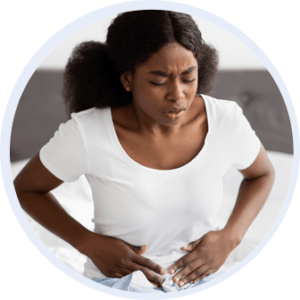Understanding pain, cramps or pressure from fibroids
If you’re a woman, you’re no stranger to pain and cramps. Women experience menstruation cycles for approximately 40 years of their life, with pain and cramps being two of the most common symptoms. But they shouldn’t always be brushed off as part of your cycle.
Understanding the causes and treatment options for pelvic pain associated with fibroids is crucial for alleviating discomfort and improving quality of life.
Understanding the Mechanism of Fibroid-Related Pelvic Pain
The location, size, and number of fibroids play a significant role in determining whether they cause pelvic pain and pressure. When fibroids grow large or are located in specific areas of the uterus, they can exert pressure on surrounding organs and nerves, leading to discomfort and pain.
Common Locations of Fibroid-Related Pelvic Pain
Pelvic pain from fibroids can manifest in various regions of the lower abdomen, including:
-
- Lower anterior pelvic pain: This occurs when fibroids are located at the front of the uterus, putting pressure on the bladder. It can cause frequent urination, urgency, and difficulty emptying the bladder.
- Deep pelvic pain: This occurs when fibroids are located deep within the uterus, putting pressure on the intestines. It can lead to constipation, bloating, and abdominal cramps.
- Lower back pain: This occurs when fibroids are located at the back of the uterus, putting pressure on the rectum and sciatic nerve. It can cause backaches, rectal pressure, and pain radiating down the leg.
Factors Influencing Fibroid-Related Pelvic Pain
Several factors can influence the intensity and frequency of pelvic pain associated with fibroids, including:
-
- Size of fibroids: Larger fibroids tend to cause more pain and pressure than smaller ones.
- Location of fibroids: Fibroids located in certain areas of the uterus, such as near the bladder or nerves, are more likely to cause pain.
- Individual pain tolerance: Pain perception varies from person to person, and some women may experience more severe pain than others with similar fibroid conditions.
Managing Pelvic Pain from Fibroids
While fibroids can cause discomfort, there are various ways to manage pelvic pain and improve quality of life:
-
- Over-the-counter pain relievers: Nonsteroidal anti-inflammatory drugs (NSAIDs) such as ibuprofen or naproxen can help alleviate mild to moderate pain.
- Heat therapy: Applying a heating pad or hot water bottle to the lower abdomen can help relax muscles and reduce pain.
- Lifestyle modifications: Maintaining a healthy weight, engaging in regular exercise, and managing stress can help reduce overall discomfort.
- Prescription medications: In some cases, stronger pain medications or hormonal therapies may be prescribed to manage more severe pain.
When to Seek Medical Attention
While some women may experience mild pelvic pain from fibroids, others may find that the discomfort is severe, interferes with daily activities, and significantly impacts their quality of life. If you are experiencing any of the following, it is important to consult a healthcare provider:
-
- Pelvic pain that is severe or persistent
- Pain that is accompanied by bleeding, fever, or foul-smelling discharge
- Pain that interferes with daily activities, such as work, exercise, or sexual intercourse
- Pain that is not relieved by over-the-counter pain relievers or other home remedies
Treatment Options for Fibroids
While many people assume that removing the uterus during a hysterectomy is the only way to alleviate pain and cramps from uterine fibroids, there’s a less invasive option worth exploring. Uterine fibroid embolization, also known as UFE, works to shrink or completely eliminate the tumors by cutting off the blood flow that’s causing them to grow.
Approximately 90% of women who undergo UFE experience reduced symptoms, including less pain and cramps.
Uterine fibroid embolization can help you work toward a happier and healthier future that doesn’t involve fibroid symptoms. At United Fibroid & Vascular Centers, we want to be by your side during the journey.
If you’re ready to explore a safe and effective uterine fibroid procedure, it’s time to schedule a consultation with us.
Speak to a dedicated patient specialist today.
Call Toll-Free 813-445-4707
90% of women have a positive resolution of fibroid related symptoms after their UFE treatment.
Our vascular board-certified physician will discuss with you whether UFE is a good treatment option for you taking into account your lifestyle, type, size, and position of the fibroids, and any risks they may present.

